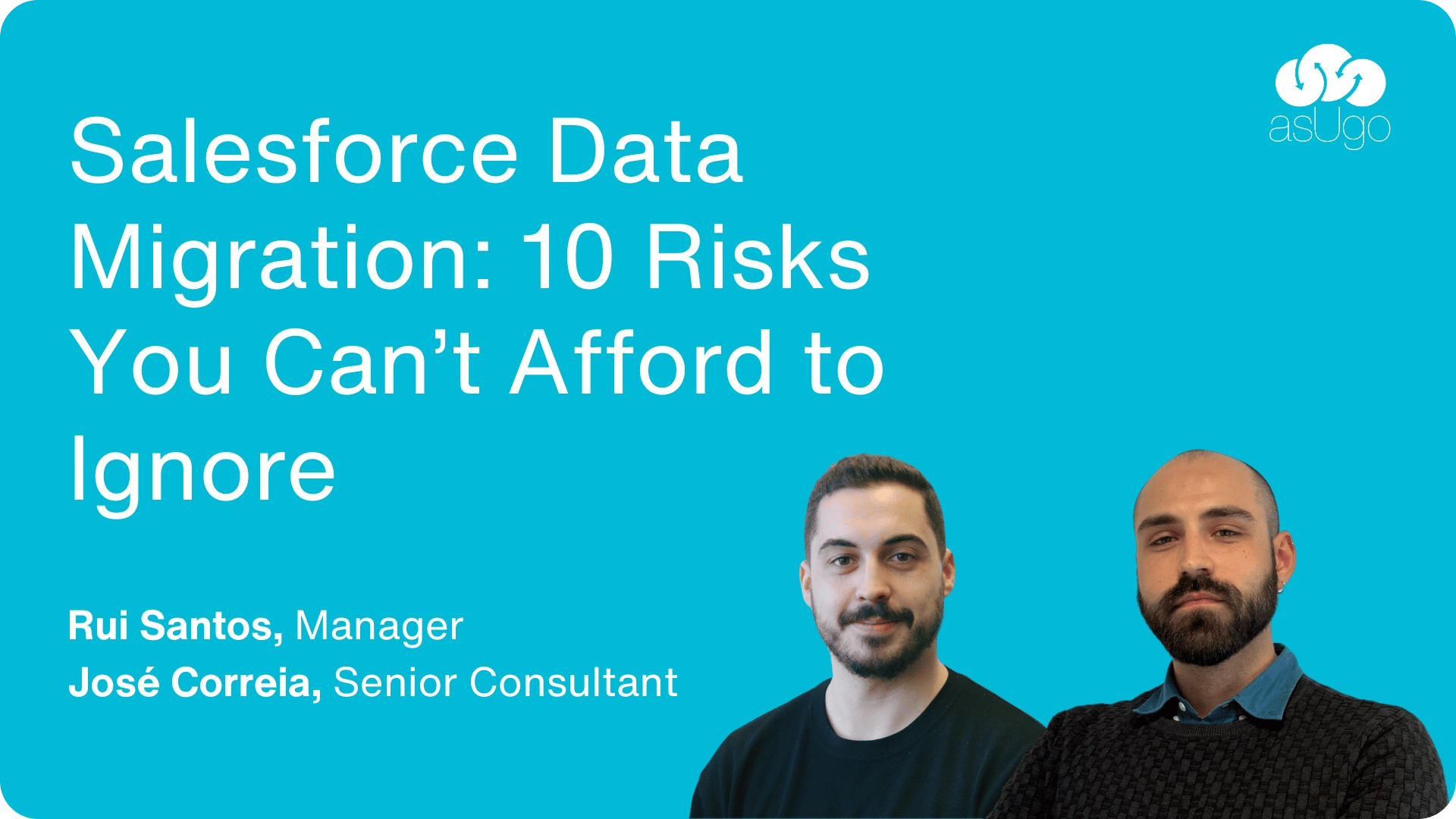
Introduction
At asUgo, we see data migration not just as a technical milestone, but as a strategic enabler of transformation within Salesforce and beyond. When done right, it lays the foundation for scalable growth and confident decision-making. Yet, the risks are real — and often underestimated. We’ve partnered with clients across industries to navigate complex migrations with precision. And if there’s one thing we’ve learned: success comes from preparation, alignment, and trust in the process.
Common Data Migration Risks
- Unclear Scope and Objectives
Without a well-defined scope, data migrations can spiral out of control. Misunderstandings about which objects or fields should be migrated, which records should be archived instead, and what quality standards apply, often lead to delays and rework. - Poor Data Quality
Migrating data “as is” without assessing its quality often results in cluttered and unreliable information in the target system. Duplicates, inconsistencies, and obsolete records can damage trust and disrupt processes. - Incomplete Data Mapping
Missing or incorrect field mappings can break data relationships, confuse users, and trigger automation failures. This risk increases when multiple source systems are involved. - Inadequate Testing
Skipping or rushing through testing stages like dry runs, UAT, or integration checks can lead to critical errors being discovered too late. - Active Automations During Data Migration
Leaving automations such as Flows, Apex Triggers, and Process Builders active can lead to unintended consequences. These automations might execute actions like sending emails, updating related records, or initiating integrations, disrupting the process and introducing data inconsistencies. - No Backup or Rollback Strategy
Without a backup, any issue during migration could lead to permanent data loss or lengthy recovery times. - Ignoring Performance and Volume Constraints
Large datasets or improperly optimized transformations can lead to failed loads and extended downtime. - Lack of Communication and Stakeholder Alignment
Poor communication creates misalignment on goals, responsibilities, and timelines. This often results in confusion during critical phases like go-live. - Skipping Post-Migration Monitoring
Assuming the migration is “done” once data is loaded can hide latent issues such as missing records, broken reports, or faulty automations. - Underestimating Business Process Impact
Even when data appears correct, it may not support business processes as expected. Misaligned permissions, broken reports, and unexpected automation behaviors can disrupt daily operations.
A successful data migration requires more than just technical tools and templates — it demands a strong partnership between IT and business. By bringing both sides together early in the process, you’ll surface hidden dependencies, clarify expectations, and pave the way for a smooth transition.
Strategies to Mitigate Data Migration Risks

- Define a Detailed Migration Scope
Establish clear objectives, success criteria, and documentation. Align all stakeholders with sign-offs to prevent scope creep. - Assess and Cleanse Data Quality
Run profiling reports, cleanse data at the source, and apply consistent validation rules. Involve business experts to verify data relevance. - Conduct Collaborative Mapping Sessions
Engage source system experts, business stakeholders, and consultants to document detailed mappings and handle complexities. - Implement Comprehensive Testing
Plan and execute multiple dry runs. Involve end-users for UAT. Include integration and automation testing to verify business processes and system behavior. - Deactivate Automations
Identify and temporarily deactivate Flows, Apex Triggers, and Process Builders that might be triggered by the migration. Re-enable only after data is validated post-load. - Establish Backup and Rollback Plans
Backup source and transformed data at every stage. Prepare rollback scripts and validate Salesforce backups before initiating the live load. - Optimize for Performance and Volume
Use robust ETL tools where possible. Monitor and document timings for extraction, transformation, and loading to detect bottlenecks early. - Develop a Communication Plan
Build a solid communication plan with regular updates, feedback loops, and training for end-users. Keep roles clear using a RACI matrix. - Monitor Post-Migration Activities
Establish a hypercare period with issue tracking and dedicated monitoring. Perform data reconciliation, monitor logs, and engage users to validate outcomes. - Test Business Processes Thoroughly
Test with real business scenarios and end-users. Validate reports, dashboards, and role-based access as part of your UAT process.
Final Thoughts
At asUgo, we believe data migration is more than a technical checklist — it’s a business-critical moment that can either propel your Salesforce ecosystem forward or weigh it down. By combining strong governance, clear communication, and hands-on collaboration, we help our clients migrate with confidence — and build a data foundation that truly supports their goals.
Authors: Rui Santos, Manager, asUgo, José Correia, Senior Consultant, asUgo






